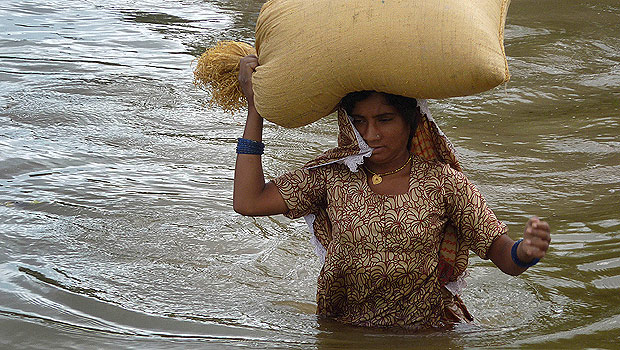The scale of the disaster and the aid response is much less than last year, but the misery for those effected is just as real. The floods began early last month, but heavy rains have compounded them recently and hampered relief efforts.
On Tuesday, thousands of men, women and children lined the main road in Badin, the worst hit district around 200 kilometers from Karachi, the country’s largest city. Some were sitting under plastic sheets held up by the branches of trees.
“There was heavy rain overnight and when we came out of our home we found ourselves stranded in high waters,” said Sham Lal. He was with his seven children and a few household possessions by the side of the road, the highest ground around.
“There is nobody to rescue us and I am worried where to go,” he said.
The affected area is southern Sindh province, which was also badly hit in the 2010 floods.
The United Nations is rushing food and tents there after Islamabad formally asked for foreign assistance this weekend. Japan and China have also pledged relief goods or money, according to the Pakistan government. The United States said it had paid for food packages for 23,000 families, and that its local partners would soon begin handing out tents, clean water and other supplies.
The return of the floods is testament to the heaviness of the monsoon rains that lash much of South Asia from June to September, as well as the limits of Pakistan’s weak and corrupt government.
As they did last year, the floods are undercutting the legitimacy of the shaky government, which is already widely disliked and struggling against Islamist militants, ever present political turmoil and massive economic problems.
“The situation is extremely bad,” said Provincial Minister Muzaffar Shajra Tuesday. “We cannot carry out relief operations because of continuos rains.”
More than 200 people have been killed, 200,000 made homeless and 4.2 million acres of agricultural land have been inundated, authorities say. Most of the displaced are staying in camps, under whatever shelter they can find or in the open.
The town of Tando Bago, where Hameed lives, has been flooded with several feet of water in places, making it impossible for residents to bury their loved ones at a local graveyard, which is also flooded.
“We are stranded and we need to get out immediately to somewhere safer so we can survive,” Hameed said by telephone. He buried his daughter in the courtyard of his house on Friday.
In 2010, the floods followed the course of the River Indus and its tributaries from the foothills of the Himalayas to the flatlands of Sindh, where the river empties out into the Arabian Sea.
As much as one-fifth of the country’s landmass and 20 million people were affected at the peak, making it one of the largest natural disasters in recent history. The US army deployed helicopters to ferry victims and aid around the country, and the UN and other international aid groups also helped.
Across the border in India, monsoon raids have also been causing havoc, killing at least 16 people and leaving nearly 100,000 others homeless in Orrissa state. The region has seen incessant rains for 10 days, a government minister there said.










